|
Integument
In biology, an integument is the tissue surrounding an organism's body or an organ within, such as skin, a husk, Exoskeleton, shell, germ or Peel (fruit), rind. Etymology The term is derived from ''integumentum'', which is Latin for "a covering". In a transferred, or figurative sense, it could mean a cloak or a disguise. In English, "integument" is a fairly modern word, its origin having been traced back to the early seventeenth century; and refers to a material or layer with which anything is enclosed, clothed, or covered in the sense of "clad" or "coated", as with a skin or husk. Botanical usage In botany, the term "integument" may be used as it is in zoology, referring to the covering of an organ. When the context indicates nothing to the contrary, the word commonly refers to an envelope covering the nucellus of the Ovule#Integuments, chivai and chalaza, ovule. The integument may consist of one layer (unitegmic) or two layers (bitegmic), each of which consisting of two or ... [...More Info...] [...Related Items...] OR: [Wikipedia] [Google] [Baidu] [Amazon] |
Seed
In botany, a seed is a plant structure containing an embryo and stored nutrients in a protective coat called a ''testa''. More generally, the term "seed" means anything that can be Sowing, sown, which may include seed and husk or tuber. Seeds are the product of the ripened ovule, after the embryo sac is fertilization, fertilized by Pollen, sperm from pollen, forming a zygote. The embryo within a seed develops from the zygote and grows within the mother plant to a certain size before growth is halted. The formation of the seed is the defining part of the process of reproduction in seed plants (spermatophytes). Other plants such as ferns, mosses and marchantiophyta, liverworts, do not have seeds and use water-dependent means to propagate themselves. Seed plants now dominate biological Ecological niche, niches on land, from forests to grasslands both in hot and cold climates. In the flowering plants, the ovary ripens into a fruit which contains the seed and serves to disseminate ... [...More Info...] [...Related Items...] OR: [Wikipedia] [Google] [Baidu] [Amazon] |
Ovule
In seed plants, the ovule is the structure that gives rise to and contains the female reproductive cells. It consists of three parts: the ''integument'', forming its outer layer, the ''nucellus'' (or remnant of the sporangium, megasporangium), and the female gametophyte (formed from a haploid megaspore) in its center. The female gametophyte — specifically termed a ''megagametophyte'' — is also called the ''embryo sac'' in Flowering plant, angiosperms. The megagametophyte produces an ovum, egg cell for the purpose of fertilization. The ovule is a small structure present in the ovary. It is attached to the placenta by a stalk called a funicle. The funicle provides nourishment to the ovule. On the basis of the relative position of micropyle, body of the ovule, chalaza and funicle, there are six types of ovules. Location within the plant In flowering plants, the ovule is located inside the portion of the flower called the gynoecium. The Ovary (plants), ovary of the gynoecium p ... [...More Info...] [...Related Items...] OR: [Wikipedia] [Google] [Baidu] [Amazon] |
Integumentary System
The integumentary system is the set of organs forming the outermost layer of an animal's body. It comprises the skin and its appendages, which act as a physical barrier between the external environment and the internal environment that it serves to protect and maintain the body of the animal. Mainly it is the body's outer skin. The integumentary system includes skin, hair, scales, feathers, hooves, claws, and nails. It has a variety of additional functions: it may serve to maintain water balance, protect the deeper tissues, excrete wastes, and regulate body temperature, and is the attachment site for sensory receptors which detect pain, sensation, pressure, and temperature. Structure Skin The skin is one of the largest organs of the body. In humans, it accounts for about 12 to 15 percent of total body weight and covers 1.5 to 2 m2 of surface area. The skin (integument) is a composite organ, made up of at least two major layers of tissue: the epidermis and the dermis. The ... [...More Info...] [...Related Items...] OR: [Wikipedia] [Google] [Baidu] [Amazon] |
Skin
Skin is the layer of usually soft, flexible outer tissue covering the body of a vertebrate animal, with three main functions: protection, regulation, and sensation. Other animal coverings, such as the arthropod exoskeleton, have different developmental origin, structure and chemical composition. The adjective cutaneous means "of the skin" (from Latin ''cutis'' 'skin'). In mammals, the skin is an organ of the integumentary system made up of multiple layers of ectodermal tissue and guards the underlying muscles, bones, ligaments, and internal organs. Skin of a different nature exists in amphibians, reptiles, and birds. Skin (including cutaneous and subcutaneous tissues) plays crucial roles in formation, structure, and function of extraskeletal apparatus such as horns of bovids (e.g., cattle) and rhinos, cervids' antlers, giraffids' ossicones, armadillos' osteoderm, and os penis/ os clitoris. All mammals have some hair on their skin, even marine mammals like whales, ... [...More Info...] [...Related Items...] OR: [Wikipedia] [Google] [Baidu] [Amazon] |
Animal Anatomy
Anatomy () is the branch of Morphology (biology), morphology concerned with the study of the internal structure of organisms and their parts. Anatomy is a branch of natural science that deals with the structural organization of living things. It is an old science, having its beginnings in prehistoric times. Anatomy is inherently tied to developmental biology, embryology, comparative anatomy, evolutionary biology, and phylogeny, as these are the processes by which anatomy is generated, both over immediate and long-term timescales. Anatomy and physiology, which study the structure and function (biology), function of organisms and their parts respectively, make a natural pair of related disciplines, and are often studied together. Human anatomy is one of the essential basic sciences that are applied in medicine, and is often studied alongside physiology. Anatomy is a complex and dynamic field that is constantly evolving as discoveries are made. In recent years, there has been a ... [...More Info...] [...Related Items...] OR: [Wikipedia] [Google] [Baidu] [Amazon] |
Exoskeleton
An exoskeleton () . is a skeleton that is on the exterior of an animal in the form of hardened integument, which both supports the body's shape and protects the internal organs, in contrast to an internal endoskeleton (e.g. human skeleton, that of a human) which is enclosed underneath other soft tissues. Some large, hard and non-flexible protective exoskeletons are known as mollusc shell, shell or armour (anatomy), armour. Examples of exoskeletons in animals include the arthropod exoskeleton, cuticle skeletons shared by arthropods (insects, chelicerates, myriapods and crustaceans) and tardigrades, as well as the corallite, skeletal cups formed by hardened secretion of stony corals, the test (biology), test/tunic of sea squirts and sea urchins, and the prominent mollusc shell shared by snails, bivalvia, clams, tusk shells, chitons and nautilus. Some vertebrate animals, such as the turtle, have both an endoskeleton and a turtle shell, protective exoskeleton. Role Exoskeletons c ... [...More Info...] [...Related Items...] OR: [Wikipedia] [Google] [Baidu] [Amazon] |
Dorsal Artery Of The Penis
The dorsal artery of the penis is a bilaterally paired terminal branch of the internal pudendal artery which passes upon the dorsum of the penis to the base of the glans penis, where it unites with its contralateral partner and supply the glans and foreskin. The dorsal artery of the penis provides blood supply to the skin and fascia of the penis (including the foreskin), and the erective tissues of the penis (especially the glans penis). The dorsal artery of the penis may be damaged in traumatic amputation of the penis and repairing the dorsal artery surgically prevents skin loss, but it is not essential for sexual and urinary function. Its hemodynamics and blood pressure can be assessed to test for sexual impairment. Structure The homologous artery in the female is the dorsal artery of clitoris. Origin The dorsal artery of the penis is a terminal branch of the internal pudendal artery, arising at the inferior border of the symphysis pubis. Course and relations It ... [...More Info...] [...Related Items...] OR: [Wikipedia] [Google] [Baidu] [Amazon] |
Botany
Botany, also called plant science, is the branch of natural science and biology studying plants, especially Plant anatomy, their anatomy, Plant taxonomy, taxonomy, and Plant ecology, ecology. A botanist or plant scientist is a scientist who specialises in this field. "Plant" and "botany" may be defined more narrowly to include only land plants and their study, which is also known as phytology. Phytologists or botanists (in the strict sense) study approximately 410,000 species of Embryophyte, land plants, including some 391,000 species of vascular plants (of which approximately 369,000 are flowering plants) and approximately 20,000 bryophytes. Botany originated as history of herbalism#Prehistory, prehistoric herbalism to identify and later cultivate plants that were edible, poisonous, and medicinal, making it one of the first endeavours of human investigation. Medieval physic gardens, often attached to Monastery, monasteries, contained plants possibly having medicinal benefit. ... [...More Info...] [...Related Items...] OR: [Wikipedia] [Google] [Baidu] [Amazon] |
Cat Anatomy
Cat anatomy comprises the anatomical studies of the visible parts of the body of a domestic cat, which are similar to those of other members of the genus ''Felis''. Mouth Permanent teeth Cats are carnivores that have highly specialized teeth. There are four types of permanent teeth that structure the mouth: twelve ''incisors'', four ''Canine tooth, canines, ''ten ''premolars'' and four ''molar (tooth), molars.'' The premolar and first molar are located on each side of the mouth that together are called the carnassial pair. The carnassial pair specialize in cutting food and are parallel to the jaw. The incisors located in the front section of the lower and upper mouth are small, narrow, and have a single root. They are used for grasping and biting food. Deciduous teeth A cat also has a deciduous dentition prior to the formation of the permanent one. This dentition emerges seven days after birth and it is composed of 26 teeth with slight differences. The mouth will have sm ... [...More Info...] [...Related Items...] OR: [Wikipedia] [Google] [Baidu] [Amazon] |






